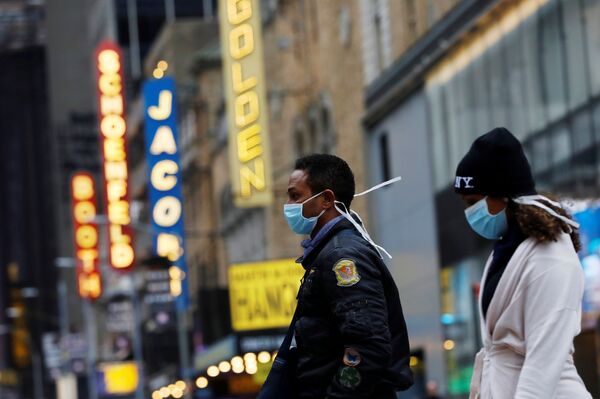According to sex-disaggregated data compiled by global researchers, there is a clear gender gap in coronavirus-related deaths with men proven to be more vulnerable to the disease than women.
Global Health 50/50, an initiative that advocates for gender equality in health, has compiled data on cases and deaths reported by sex across 35 countries. The initiative's COVID-19 data tracker indicates that the proportion of deaths between men and women amounts to:
· 13.3 versus 7.4 (Italy);
· 4.7 versus 2.8 (China);
· 8.4 versus 4.7 (Spain);
· 10.6 versus 6.6 (The Netherlands);
· 4.0 versus 1.7 (Ireland).
Having unveiled the trend, the world's health researchers are now struggling to understand why the virus is so much more deadly for males, naming biology, lifestyle and behaviour as the most likely factors being at play.
Risky Behaviour & Unhealthy Lifestyle
"I think the best answer to begin with is - we don't hundred percent know why, right?" says Dr Bharat Pankhania, senior clinical lecturer at University of Exeter Medical School, the UK. "We have many theories as to why. But the best answer is for unexplained reasons men seem to have more attrition than women".
To illustrate his point Dr Pankhania suggests that "men undertake more hazardous activities starting from early life onwards" being exposed to more challenges to their health.`
According to BMJ Global Health blog, preliminary studies have indicated that patients with severe COVID-19 cases usually suffered from existing co-morbidities including hypertension, cardiovascular disease and some chronic lung diseases. Statistics show that men are more likely to have these conditions than women. Researchers associate this difference to higher levels of risky behaviours which are more typical for males than females.
"What we're working on is the hypothesis that we can see that having a risk of death from COVID-19 is also associated with having the presence of other diseases, particularly heart and lung diseases", explains Sarah Hawkes, a medical doctor the director of the UCL Centre for Gender and Global Health in the UK. "And from all of the work that we've done over many years, with diseases, heart and lung are more common in men compared to women. And we also see that many of the behaviours that lead to a risk of heart and lung disease are more common in men compared to women".
Yet another problem is smoking: "I think smoking definitely plays a big role - in smoking related extra deaths from coronavirus as well", Dr Pankhania notes.
Citing high lethality rates from COVID-19 among elderly people, the researcher highlights that "men who are 60 plus or even 50 plus would have been smokers more than women".
Indeed, as of 2015, the global male-to-female ratio of smoking prevalence amounted to 36% of men and 7% of women. According to Global Health 50/50, consumption of tobacco products has been increasingly associated with adverse outcomes in COVID-19.
In general, "there are lots of how do you call it behavioural issues with men that I've clearly shown that the coronavirus is levelling them", Dr Pankhania points out outlining diet, heart disease, weight, and smoking as the key factors.
"When you start putting all these things together, it appears that, because men undertake all these extra activities, they're more vulnerable", he highlights.
Why Biological Differences Matter
The scholar does not believe that differences between women and men in immune response to the virus contribute to the trend. However, biological causes do play a role, he admits.
"I don't think it has anything to do with immunity", the clinical lecturer opines. "But what I am referring to is that the man's lungs have to support more muscle, bigger organs, bigger body, bigger body weight, maybe overweight, even more. And so it is a little bit like - let us assume - it is a small car - say, a Skoda. And then that Skoda is expected to power and pull a big lorry. And normally it can. But when you have an extra load on you, so you have heart disease, you have extra muscles, you have extra fat, you have extra body to feed with oxygen and your lungs have been assaulted with coronavirus the lungs become unable to cope with feeding the whole body with fresh oxygen".
Sarah Hawkes holds a different stance placing emphasis on immune dissimilarities between the two sexes.
"We know that there are clear differences in the immune systems of men and women", she says. "Because what men and women's bodies are designed to do different things throughout the life, of course. So there are clear differences in immunology and in hormone profiles. And it could be that that is driving some of the reasons why we see the higher death rates in men".
Some researchers are singling out oestrogen, the primary female sex hormone, as a biological factor making women's immune system more resistant to the virus. Thus, Wired cites an experiment carried out by microbiologists from the University of Iowa in 2016-2017 who infected male and female mice of different age groups with SARS-CoV. The experiment indicated that male mice were more vulnerable to infection compared to age matched females. However, when the scientists removed the ovaries – an organ producing and releasing oestrogen – from female mice their mortality from the virus sharply increased.
Meanwhile, scientists are raising the alarm over the fact that it is not the first time that coronaviruses have hit the menfolk of the world more severe than anyone else: epidemiological data from the 2002-2003 SARS-CoV and the 2012 MERS-CoV outbreaks demonstrate that infected males faced a higher risk of dying than females. Still, the question as to how exactly sex and gender influence risks of acquisition and transmission of coronaviruses as well as resistivity to the disease remains open.


